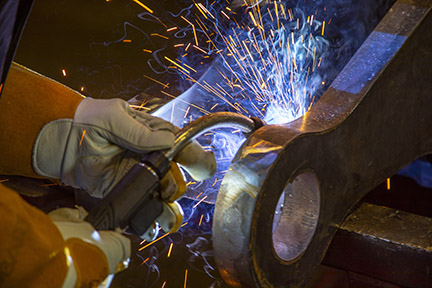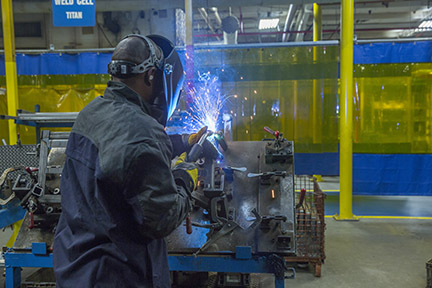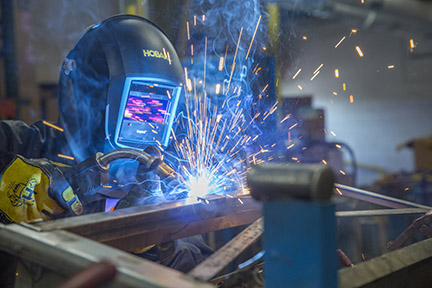Learn the Best-Kept Secrets to Avoiding Costly Welding Failure
Weld failures can result from weld defects, such as cracking or inclusions. However, there are a number of other issues in the welding operation that can also contribute to the problem. Whatever the cause, there is the potential for these failures to be catastrophic should they occur in a load-bearing application. The goal, of course, is to identify and avoid weld failure to avoid property damage or personal injury.
While safety is the top reason for preventing weld failures, it is important to consider the lost productivity and increased costs associated with reworking poor-quality welds. It takes a considerable amount of time to do this, particularly for longer welds or multi-pass welds on thicker sections.
Understanding common reasons for weld failures and how to prevent them helps welders maintain high levels of quality and efficiency.
Reason 1: Poor part or weld design
Insufficient weld size — because of design errors or incorrect interpretation of the part design – can lead to weld failures. This is due to the inability of an undersized weld to support the intended load in a static structure. A weld that is too small or too short for the application can fail from tension, compression, bending or torsional loads. If a weld is made for an application where a cyclical load is going to be applied, consider a filler metal with increased impact toughness and ductility.
In a highly restrained joint, meeting required weld sizes is critical — otherwise cracking can potentially occur. Where a highly restrained joint is unavoidable, welds with a proper depth-to-width ratio help reduce the chances of weld cracking. Proper welding parameters ensure that an adequate weld profile is being produced. This reduces the risk of weld cracking in a restrained joint.
Weld design
Factor of safety (FoS) is an important variable to consider during the design phase. This establishes the maximum allowable stress for the joint, ensuring the component being produced can withstand loads greater than intended. If welds are failing, it is possible that the intended maximum load is not properly communicated. This can also be because the design’s factor of safety is too low; the engineer must consider foreseeable misuse of products.
It is commonly desired to make a weld with a matching filler metal strength, but that can change depending on the application and base material being welded. For certain critical applications, it may be valuable to design the weldment with an overmatch in filler metal strength. Other applications are best served with a strength undermatch to improve fatigue life or weldability. Along with strength, chemistry is important during weld design to gain proper fusion and achieve the desired weld properties.
Reason 2: Inadequate welding procedure
Neglecting to follow the proper welding procedure or writing an inadequate procedure is another contributing factor to weld failure. Remember to properly utilize preheat and control interpass temperature. Properly written procedures with adequate preheat and interpass temperature slow the rate of cooling in the base material and the weld deposit. This ultimately helps reduce the risk of hydrogen cracking when welding carbon and low alloy steels or similar materials.
When creating a welding procedure, start by referring to the filler metal product data sheet for welding parameter recommendations. Each filler metal has slightly different characteristics, and parameters are not one-size-fits-all. Proper parameter ranges on the welding procedure help provide consistently sound welds. Consider conducting some additional testing, such as cut and etch, bends, pulls, or breaks, to ensure sound weld quality. The welding code that is being used will provide a standard to validate proper weld quality.

quality — including proper joint penetration and correct weld size.
Always make sure the correct welding polarity is being used in accordance with the welding procedure and filler metal specifications. Shielding gas is another major influence that directly effects weld quality and general characteristics of a weld deposit. Higher argon content in a shielding gas mixture increases strength but lowers ductility. Conversely, higher amounts of carbon dioxide lower strength and increase ductility. Always check that the shielding gas being used is within the range recommended by the filler metal manufacturer.
Reason 3: Stress risers
Stress risers are caused by poor weld design and inadequate welding procedures or technique. They also appear in the form of weld defects or discontinuities that cause stress on the weld. This can lead to failures by way of breaking, tearing or cracking.
There are several types of stress risers and options for preventing them.
Porosity
Porosity occurs when gas becomes trapped in the weld during solidification. This typically results from the environment/atmosphere or improper shielding when welding steel. Shielding gas can also become trapped and cause porosity. Prevent this issue with proper part prep and removal of moisture from the weld area. Also ensure optimal shielding gas coverage (e.g., flow rate, angles, gas cup and a leak-free system) and adequate preheat.
Hot Cracking
Hot cracking typically appears in the longitudinal direction of the weld at high temperatures (usually over 1,000 degrees Fahrenheit) and almost immediately after cooling. This can be segregation cracking, where elements with low melting points reject the center of the weld when it solidifies. To prevent hot cracking, carefully match the filler metal and base material properties, ensure the proper joint design for the application and follow all welding procedures. Preheat and interpass temperature control are also important.
Cold Cracking
Cold cracking commonly occurs at temperatures below 600 degrees Fahrenheit. Because of this, cold cracking may not be noticeable until hours or days after the weld solidifies. It is often referred to as hydrogen-induced or heat-affected zone (HAZ) cracking. Using low-hydrogen filler metals and preheating the base material are good defenses against this defect.
Undercut
Undercut typically results from excessive voltage and incorrect travel angle. Underfill is typically caused by travel speeds that are too fast for a given deposition rate. Reducing travel speed to allow for adequate fill, reducing voltage and using proper travel angles can remedy the issue. Increasing wire diameter can also help to achieve desired travel speeds while allowing for proper deposition and fill rates.
Inclusions
Inclusions are caused by foreign materials in the weld. Burrs on the base material or slag from a shielded metal arc welding (SMAW) electrode or a flux-core arc welding (FCAW) wire can contribute to inclusion. Prevent them by properly cleaning the base material and using a drag technique to keep slag out of the weld pool.
Reason 4: Poor welding technique
Poor welding technique can be attributed to a lack of training, newer welding operators with lower skill sets, or more experienced welders who may have acquired bad habits. Whichever the case, incorrect techniques can affect weld quality and may lead to failures.
Using the proper work and travel angles are important means to prevent issues like undercut or an improperly sized weld. These angles will differ according to the filler metal being used. Work angle refers to how the welding gun or electrode is positioned in relation to the vertical member of the weld joint. Travel angle describes how the filler metal is positioned in relation to the weld pool and direction of travel. As mentioned previously, use a drag technique when welding with SMAW electrode or FCAW wire due to the slag system. For solid wires or metal-cored wires that do not produce slag, a forehand or push technique is typically recommended.
Contact-tip-to-work-distance

experienced welding operators.
The contact-tip-to-work-distance (CTWD) is another factor welding operators need to be mindful of to prevent poor weld quality and potential failures. CTWD increases or decreases amperage in a constant voltage (CV) process and changes voltage in a constant current (CC) process. A CTWD that is too long can cause an amperage drop, lack of penetration, and/or loss of shielding gas. When the CTWD is too tight, porosity or worm tracks can present themselves when using FCAW wires. CTWD varies according to the filler metal being used. For example, E70T-1/E71T-1 gas-shielded FCAW wires usually have a CTWD between 1/2 and 1 inch, depending on the wire diameter (the bigger the diameter, the greater the CTWD). An E71T-8 self-shielded FCAW wire may require up to 1-1/2-inch CTWD.
The correct travel speed is also important, as it can dramatically change weld size and bead appearance. Traveling too fast creates a thin, undersized and ropey weld that may lack strength; traveling too slow can lead to lack of penetration and a larger, flatter weld.
Reason 5: Incorrect inspection or testing
Not all welding applications require weld testing or welding to code; however, when these are necessary, welding codes provide a reliable and proven system to qualify welding procedures and guide welders to produce acceptable weld quality.
Always use code-approved testing standards for new procedure development, focusing on the correct number and type of testing for mechanical and chemical properties and/or non-destructive testing. The material being welded and how strict or critical the application is factors into how stringent testing should be. The code will specify acceptance criteria for production-made welds using either penetrant testing (PT), magnetic particle testing (MP), radiographic testing (RT) and/or ultrasonic testing (UT).
Follow code-approved inspection criteria to ensure welds meet the appropriate size, shape and do not exceed the allowable discontinuity limit requirements. Codes dictate an allowable range of discontinuities in a weld — such as porosity — before it is considered a defect that must be reworked.
Welding inspection — visually, at a minimum — should be performed regularly in all applications, even if they do not have to adhere to welding codes. Be consistent and critical of weld quality and make the inspection process a priority to avoid weld failures.
Putting it all together
Establishing and enforcing a quality system for welding operations, as well as implementing training is key to preventing weld failures — for both new and more experienced welding operators. It never hurts to pursue refresher courses in welding basics or to practice techniques to help establish good habits and gain positive results. Doing so can benefit the entire welding operation, in terms of improved quality, productivity and cost savings.



